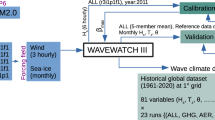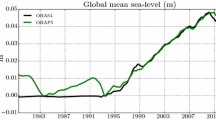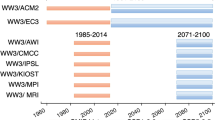Abstract
This paper evaluates the performance of the spectral wave model WAVEWATCH III for the South Atlantic Ocean forced by wind inputs from the most recent reanalyses, NCEP/CFSR and ECMWF/ERA5, combined with two different source terms: ST4 and ST6. A calibration is performed considering 1 year (2012) and 31 simulations, evaluated against altimeter and buoy data through six error metrics and Q-Q plots. Assessment results suggest that both ST4 and ST6 provide good results when WAVEWATCH III is properly adjusted for the wind input. Nevertheless, the wave model presents a positive bias of significant wave height when forced by CFSR winds that requires attention. The investigation in the spectral domain indicates a better performance of wave simulations forced by ERA5 winds, especially for wave periods below 10 s. For wave periods above 10 s, the choice of source term package becomes more important. In this regard, ST4 parameterization combined with ERA5 winds presents the best results for the region. The optimal range of calibration parameters for each wind input and source term package is reported and discussed.









Similar content being viewed by others
The wave buoys data that support the findings of this study are available in the Brazilian National Program (PNBOIA) repository (link below). The altimetry data is from Ifremer Merged Altimeter Database and it is available in CERSAT repository through the link below. The wind products (from CFSR and ERA5) are also available to the public and were derived from the following public domain resources:
PNBOIA - https://www.marinha.mil.br/chm/dados-do-goos-brasil/pnboia-mapa
CERSAT - http://cersat.ifremer.fr/thematic-portals/projects/globwave
CFSR - https://rda.ucar.edu/datasets/ds094.1/
ERA5 - https://www.ecmwf.int/en/forecasts/datasets/reanalysis-datasets/era5
References
Alves JHGDM, Ribeiro EO, Matheson GSG, Lima JAM, Ribeiro CEP (2009) Reconstituição do clima de ondas no sul-sudeste brasileiro entre 1997 e 2005. Rev Brasil Geofís 27:427–445
Amante C, Eakins B (2009) Etopo1 1 arc-minute global relief model: procedures, data sources and analysis Noaa technical memorandum. National Geophysical Data Center, NOAA
Ardhuin F, Chapron B, Collard F (2009) Observation of swell dissipation across oceans. Geophys Res Lett 36(6)
Ardhuin F, Rogers E, Babanin AV, Filipot J -F, Magne R, Roland A, van der Westhuysen A, Queffeulou P, Lefevre J -M, Aouf L, Collard F (2010) Semiempirical dissipation source functions for ocean waves. Part i: definition, calibration, and validation. J Phys Oceanogr 40(9):1917–1941
Babanin AV, Jiang H (2017) Ocean swell: how much do we know. In: International conference on offshore mechanics and arctic engineering, volume 3A: structures, safety and reliability of international conference on offshore mechanics and arctic engineering
Bidlot J -R, Janssen P, Abdalla S (2007) A revised formulation of ocean wave dissipation and its model impact. Technical Memorandum, p 27
Campos R, Ribeiro C, De Camargo R (2012) Extreme wave analysis in campos basin (Rio de Janeiro - Brazil) associated with extra-tropical cyclones and anticyclones. In: Proceedings of the international conference on offshore mechanics and arctic engineering - OMAE, vol 2
Campos R, Guedes Soares C (2016a) Comparison and assessment of three wave hindcasts in the north Atlantic ocean. J Oper Oceanogr 9:1–19
Campos RM, Guedes Soares C (2016b) Estimating extreme waves in Brazil using regional frequency analysis. In: Proceedings of the international conference on offshore mechanics and arctic engineering - OMAE, volume 3: structures, safety and reliability
Campos R, Alves J, Soares CG, Guimaraes L, Parente C (2018) Extreme wind-wave modeling and analysis in the south Atlantic ocean. Ocean Model 124:75–93
Chawla A, Spindler DM, Tolman HL (2013) Validation of a thirty year wave hindcast using the climate forecast system reanalysis winds. Ocean Model 70:189–206. Ocean Surface Waves
Cuchiara D, Fernandes E, Strauch J, Winterwerp J, Calliari L (2009) Determination of the wave climate for the southern Brazilian shelf. Cont Shelf Res 29:545–555
Dee DP, Uppala SM, Simmons AJ, Berrisford P, Poli P, Kobayashi S, Andrae U, Balmaseda MA, Balsamo G, Bauer P, Bechtold P, Beljaars ACM, van de Berg L, Bidlot J, Bormann N, Delsol C, Dragani R, Fuentes M, Geer AJ, Haimberger L, Healy SB, Hersbach H, Hólm E V, Isaksen L, Kållberg P, Köhler M, Matricardi M, McNally AP, Monge-Sanz BM, Morcrette J-J, Park B-K, Peubey C, de Rosnay P, Tavolato C, Thépaut J-N, Vitart F (2011) The era-interim reanalysis: configuration and performance of the data assimilation system. Q J R Meteorol Soc 137(656):553–597
Gan MA, Rao VB (1991) Surface cyclogenesis over south America. Mon Weather Rev 119 (5):1293–1302
Godoi V, Ribeiro C, Rebelo A (2014) An overview of events of high sea waves at the mouth of guanabara bay. Pan-Am J Aquat Sci 9:70–87
Gramcianinov C, Campos R, de Camargo R, Hodges K, Guedes Soares C, da Silva Dias P (2020a) Analysis of atlantic extratropical storm tracks characteristics in 41 years of era5 and cfsr/cfsv2 databases. Ocean Eng 216:108111
Gramcianinov C, Campos R, Guedes Soares C, de Camargo R (2020b) Extreme waves generated by cyclonic winds in the western portion of the south Atlantic ocean. Ocean Eng 213:107745
Hersbach H, Bell B, Berrisford P, Hirahara S, Horányi A, Muñoz-Sabater J, Nicolas J, Peubey C, Radu R, Schepers D, Simmons A, Soci C, Abdalla S, Abellan X, Balsamo G, Bechtold P, Biavati G, Bidlot J, Bonavita M, De Chiara G, Dahlgren P, Dee D, Diamantakis M, Dragani R, Flemming J, Forbes R, Fuentes M, Geer A, Haimberger L, Healy S, Hogan RJ, Hólm E, Janisková M, Keeley S, Laloyaux P, Lopez P, Lupu C, Radnoti G, de Rosnay P, Rozum I, Vamborg F, Villaume S, Thépaut J-N (2020) The era5 global reanalysis. Q J R Meteorol Soc 146(730):1999– 2049
Innocentini V, Caetano E, Carvalho JT (2014) A procedure for operational use of wave hindcasts to identify landfall of heavy swell. Weather Forecast 29(2):349–365
Janssen PAEM (1991) Quasi-linear theory of wind-wave generation applied to wave forecasting. J Phys Oceanogr 21(11):1631–1642
Kalnay E, Kanamitsu M, Kistler R, Collins W, Deaven D, Gandin L, Iredell M, Saha S, White G, Woollen J, Zhu Y, Chelliah M, Ebisuzaki W, Higgins W, Janowiak J, Mo KC, Ropelewski C, Wang J, Leetmaa A, Reynolds R, Jenne R, Joseph D (1996) The ncep/ncar 40-year reanalysis project. Bull Am Meteorol Soc 77(3):437–472
Kalourazi MY, Siadatmousavi SM, Yeganeh-Bakhtiary A, Jose F (2021) Wavewatch-iii source terms evaluation for optimizing hurricane wave modeling: a case study of hurricane Ivan. Oceanologia 63 (2):194–213
Kobayashi S, Ota Y, Harada Y, Ebita A, Moriya M, Onoda H, Onogi K, Kamahory H, Kobayashi C, Endo H, Miyaoka K, Takahashi K (2015) The jra-55 reanalysis: general specifications and basic characteristics. J Meteorol Soc Jpn Ser II 93(1):5–48
Komen GJ, Hasselmann S, Hasselmann K (1984) On the existence of a fully developed wind-sea spectrum. J Phys Oceanogr 14(8):1271–1285
Liu Q, Rogers WE, Babanin AV, Young IR, Romero L, Zieger S, Qiao F, Guan C (2019) Observation-based source terms in the third-generation wave model WAVEWATCH III: updates and verification. J Phys Oceanogr 49(2):489–517
Parente CE (1999) Uma Nova técnica Espectral para análise Direcional de Ondas. PhD thesis, Federal University of Rio de Janeiro, Rio de Janeiro
Pereira HPP, Violante-Carvalho N, Nogueira ICM, Babanin A, Qingxiang L, de Pinho UF, Nascimento F, Parente CE (2017) Wave observations from an array of directional buoys over the southern Brazilian coast. Ocean Dyn 67:1616–7228
Pianca C, Mazzini PLF, Siegle E (2010) Brazilian offshore wave climate based on nww3 reanalysis. Braz J Oceanogr 58:53–70
Queffeulou P, Croizé-Fillon D (2017) Global altimeter swh data set–version 11.4. Technical report, IFREMER
Rapizo H, Durrant T, Babanin A (2018) An assessment of the impact of surface currents on wave modeling in the southern ocean. Ocean Dyn 68
Reboita MS, da Rocha RP, Ambrizzi T, Sugahara S (2010) South Atlantic ocean cyclogenesis climatology simulated by regional climate model (regcm3). Clim Dyn 35:1432–0894
Rienecker MM, Suarez MJ, Gelaro R, Todling R, Bacmeister J, Liu E, Bosilovich MG, Schubert SD, Takacs L, Kim G-K, Bloom S, Chen J, Collins D, Conaty A, da Silva A, Gu W, Joiner J, Koster RD, Lucchesi R, Molod A, Owens T, Pawson S, Pegion P, Redder CR, Reichle R, Robertson FR, Ruddick AG, Sienkiewicz M, Woollen J (2011) Merra: Nasa’s modern-era retrospective analysis for research and applications. J Clim 24(14):3624–3648
Saha S, Moorthi S, Wu X, Wang J, Nadiga S, Tripp P, Behringer D, Hou Y-T, Chuang H-Y, Iredell M, Ek M, Meng J, Yang R, Mendez MP, van den Dool H, Zhang Q, Wang W, Chen M, Becker E (2014) The ncep climate forecast system version 2. J Clim 27(6):2185–2208
Semedo A, Sušelj K, Rutgersson A, Sterl A (2011) A global view on the wind sea and swell climate and variability from era-40. J Clim 24
Stopa JE (2018) Wind forcing calibration and wave hindcast comparison using multiple reanalysis and merged satellite wind datasets. Ocean Model 127:55–69
Stopa JE, Cheung KF (2014) Intercomparison of wind and wave data from the ecmwf reanalysis interim and the ncep climate forecast system reanalysis. Ocean Model 75:65–83
Stopa JE, Ardhuin F, Babanin A, Zieger S (2016) Comparison and validation of physical wave parameterizations in spectral wave models. Ocean Model 103:2–17. Waves and coastal, regional and global processes
Tolman HL, Chalikov D (1996) Source terms in a third-generation wind wave model. J Phys Oceanogr 26(11):2497–2518
Valiente NG, Saulter A, Edwards JM, Lewis HW, Castillo Sanchez JM, Bruciaferri D, Bunney C, Siddorn J (2021) The impact of wave model source terms and coupling strategies to rapidly developing waves across the north-west European shelf during extreme events. J Mar Sci Eng 9(4)
Violante-Carvalho N, Parente CE, Robinson IS, Nunes LMP (2002) On the growth of wind-generated waves in a swell-dominated region in the south Atlantic. J Offshore Mech Arct Eng 124: 14–21
WW3DG (2019) User manual and system documentation of WAVEWATCH III version 6.07, The WAVEWATCH III Development Group. Tech. Note 326 pp. + Appendices, NOAA/NWS/NCEP/MMAB
Young IR (1999) Seasonal variability of the global ocean wind and wave climate. Int J Climatol 19(9):931–950
Young IR, Banner ML, Donelan MA, McCormick C, Babanin AV, Melville WK, Veron F (2005) An integrated system for the study of wind-wave source terms in finite-depth water. J Atmos Ocean Technol 22(7):814–831
Zieger S, Babanin A, Rogers W, Young I (2015) Observation-based source terms in the third-generation wave model wavewatch. Ocean Model 96
Acknowledgements
The authors would like to thank the Brazilian National Buoy Program (PNBOIA) of the Brazilian Navy for providing the wave data, and the Federal University of Rio de Janeiro through Laboratório de Instrumentação Oceanográfica for all the technical and scientific support. The authors acknowledge Petrobras for the collaboration and ANP (Agência Nacional de Petróleo, Gás Natural e Biocombustíveis) for the research fund. The third author has been funded by the Cooperative Institute for Marine and Atmospheric Studies (CIMAS), a Cooperative Institute of the University of Miami and the National Oceanic and Atmospheric Administration, cooperative agreement NA20OAR4320472.
Author information
Authors and Affiliations
Corresponding author
Ethics declarations
Conflict of interest
The authors declare no competing interests.
Additional information
Responsible Editor: Andrea Pinones
Publisher’s Note
Springer Nature remains neutral with regard to jurisdictional claims in published maps and institutional affiliations.
Rights and permissions
About this article
Cite this article
Kaiser, J., Nogueira, I.C.M., Campos, R.M. et al. Evaluation of wave model performance in the South Atlantic Ocean: a study about physical parameterization and wind forcing calibration. Ocean Dynamics 72, 137–150 (2022). https://doi.org/10.1007/s10236-021-01495-4
Received:
Accepted:
Published:
Issue Date:
DOI: https://doi.org/10.1007/s10236-021-01495-4




